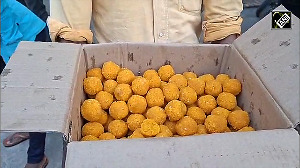In some districts of Madhya Pradesh, mothers are routinely compelled to murder female infants by placing a charpoy's leg on the child's neck. This is the brutal method adopted for several decades in hundreds of villages in the state's Bhind, Morena and a few neighbouring districts, where the desire for male offspring is overwhelming.
Sadly, the hundreds of offenders in these districts are parents themselves. The sonography machine has assumed a key role and female foeticide is a thriving business.
During a just-concluded tour organised by the Press Information Bureau, a team of journalists learnt that such crimes have assumed the dimensions of a social evil and, consequently, the gender balance in Morena and Bhind has taken a body blow.
In some villages of Morena, there are as few as 400 to 700 females for every 1,000 males. In fact, no baraat has entered these villages for 20 years.
The political system and administrative machinery have their own perception of this problem. Careful about their vote banks, political leaders refrain from saying or doing anything against this, while officials hesitate to take any open initiative as it considers the mass slaughter a 'social' issue.
While admitting the grave nature of the killings, Morena's district collector Akash Tripathi says, "An April-December 2006 survey conducted in the district painted a startling picture about the gender balance in some blocks. If conditions do not improve, girls will be on the brink of extinction in a few villages."
The bureaucrat quotes the 2001 Census figures that clearly reveal a population increase but the district's gender balance is declining. It is 822:1,000 as compared to the state's 920:1,000 and the national ratio of 933:1,000.
"At the initiative of Chambal's divisional commissioner Ajit Kesri, a meeting recently worked out a multipronged strategy to stamp out the evil in Morena, Bhind, Sheopur and Shivpuri districts. Besides a key role by voluntary organisations, assistance will be sought from religious leaders as religious events are conducted round the year in Morena," Tripathi adds.
At these events, men of religion would raise their voices against female foeticide and infanticide, he said.
Rajkumari Sharma, who is associated with the voluntary organisation Sambhav, which is toiling in Bhind's Gurikha village panchayat and surrounding villages, laments that, despite all the efforts, the picture has not brightened.
"I know of a family where six female infants were murdered one after the other," she says.
In Chambal region's rural areas, such infanticide is openly admitted.
"At a village in Bhind district, a fearful mother braved post-delivery weakness and other complications to hide in a hayloft, without food and water, for two days along with her infant daughter," says Sharma.
The woman's father and brother reached the place and assured her in-laws that they would bear the expense of the daughter's upbringing and marriage. The mother-daughter duo emerged from the hayloft but the infant was slain just a few hours later.
Chambal region's Morena and Bhind districts are famed for mustard cultivation and Morena is known as the 'mustard capital' of Madhya Pradesh but ironically, the prosperity ensured by such cultivation has further fuelled gender imbalance and the craving for male offspring.
Sociologists believe that it has become the region's undeclared tradition to have more boys for maintaining social standing in the face of the dowry evil.
"Sonography kits, doctors and technicians access remote villages in vehicles. If a male foetus is detected, they say 'gulab ka phool' (a rose is blooming) or 'thali bajao' (celebrate). The number of sonography centres in Morena is one-and-a-half times the number of nursing homes," says Devendra of the voluntary organisation Dharti which has been battling female foeticide in Morena for decades.
In Bhind district's Katrol village, this correspondent was stunned when a nine-year-old boy divulged that, soon after his sister was born, his father stuffed tobacco into her mouth and then strangled her.
After a girl is killed, the chant of 'lali ladki tu ja aur lala ladka ko le aa' (go away girl and get a boy) seems to tell a brutal story in a nutshell.





